Bioswales/ Retention ditches
Bioswales are bioengineering structures in a form resembling oblong rain gardens. They are located along pedestrian routes – sidewalks, roads, or city squares and parking lots. They are used to collect a small amount of rainwater flowing down from hardened surfaces. During overflowing rains, excess water from bioswales is discharged to storm sewers or to retention reservoirs. These structures are in the form of shallow channels with a trapezoidal or triangular cross-section. The entire structure, as in the case of rain gardens, is planted with properly selected vegetation, which is an component that enhances the esthetics of urban streets.
Their primary function is to store, infiltrate and purify rainwater (from solid and chemical contamination). They reduce surface runoff by 88%.
Environmental benefits: rainwater retention, reduction of surface runoff from hard-surfaced pavements, street parking lots, rainwater purification (sedimentation of pollutants, phytoremediation). Increasing the biodiversity in the city, creating new habitats for the fauna in the city.
Social benefits: educational aspects, decorative aspects.
Economic benefits: reducing the cost of draining rainwater to the storm sewer system (and – more importantly in the context of sudden weather phenomena – relieving it at a critical moment).
They are part of creating green networks in the city: together with green roofs, green walls, rain gardens, swales, retention reservoirs.
A solution for professionals and local communities.
Construction:
– They are located along the edges of sidewalks, streets, city squares and parking lots. Water flows into them by gravity thanks to specially made gutters in the edges of roads, sidewalks, etc. The fall in these places should be at least 5 cm. An important component of the design are specially selected plant species, resistant to soil environmental conditions and water pollution. Native species that do not require much maintenance are preferred for planting bioswales. The plants should also be deeply rooted so that the phytoremediation process is more efficient. We commence the system 3 months after planting so that the plants have time to take root.
For safety reasons (against local flooding), these gardens are equipped with drainage located directly under the elongated basin. The drains are embedded in a gravel bed. If necessary, excess water is discharged to a traditional storm sewage system or a retention reservoir.
– They should have an oval or trapezoidal cross-section. The slope of the walls is not more than 3:1.
– The substrate should be porous to retain rainwater (in addition, appropriate bacterial strains contributing to the treatment of rainwater develop in these spaces). The substrate should contain a maximum of 5% clay.
The water in bioswales should drop at a rate of 12-25 cm per hour, infiltrating into the deeper layers of the earth. Hence, it is important that the native land on which the bioswale is located is not contaminated. Water also evaporates as a result of the evaporation process in leaf blades.
– In the case when the structure of the bioswale is quite long and there is a certain slope of the terrain, small dams should be built and the bioswale’s centerline should be meandered so as to slow down the flow of the water in it.
– Capacity should be adjusted to the 10-year rainfall.
– The compositions often include various types of rocks, stones, etc., which protects the plants from being washed away during heavy rainfall (protection against erosion).
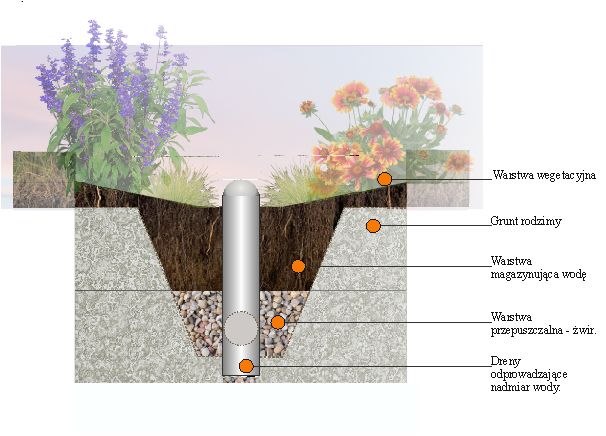
An exemplary set of bioswale greening plants:
| Latin name | English name | Environmental requirements | Remarks |
| Salix purpurea ‘Nana’ | Purple willow ‘Nana’ | A small shrub for dry-to-wet locations, tolerant to soil pH, prefers sunny-to-slightly shaded locations. | Requires trimming. |
| Cotoneaster lucidus | Shiny cotoneaster | The shrub is tolerant to the type of substrate and insolation. Resistant to environmental pollution. | Suitable for intensive trimming. |
| Cephalanthus occidentalis | Common cottonbush | A small shrub. It prefers sunny, wet or moist soils. | Its flowers attract butterflies. |
| Hippophae rhamnoides | Sea buckthorn | Prefers poor soils and sunny positions. | Resistant to contamination. |
| Spirea tomentosa | Steeplebush | A small shrub. It prefers moist soils and sunny positions. | |
| Viburnum nudum | Whiterod viburnum | A small shrub, undemanding in terms of the soil, it prefers moist, sunny, but also shaded locations. Frost-resistant. | An ornamental plant due to the color of the infructescence. |
| Achillea millefolium | Common yarrow | A perennial plant for sunny positions, tolerant to the type of soil. | Good for urban plantings. |
| Carex sp.
|
Sedges | Group of perennials tolerant to habitat conditions. They can be planted at the streets as it tolerates soil salinity. | |
| Coreopsis lanceolata
|
Lance-leaved coreopsis | A perennial plant for sunny positions, tolerant in terms of the soil. It has ornamental yellow flowers. | |
| Echinacea purpurea
|
Purple coneflower | A perennial plant for sunny and semi-shaded positions. Resistant to the type of substrate. It is used for urban plantings and is characterized by pink decorative flowers. | |
| Filipendula rubra
|
Queen-of-the-prairie | A decorative perennial for sunny and humid positions. Pink color of flowers. | |
| Liatris spicata
|
Prairie gay feather | A perennial with decorative elongated purple inflorescences for sunny positions. Requires fertile and moist soil. | |
| Rudbeckia fulgida | Orange coneflowe | A perennial with decorative long blooming flowers. Suitable for sunny positions. Tolerant tolerant in terms of the soil. | For urban plantings. |
Source: http://www.cultural-landscape.us.edu.pl/images/seria/41/9dudzinska.pdf
Examples:
A project from Gdańsk: Modernist housing estate on Wilhelma Stryjewskiego Street.
A comprehensive project – where we have several types of rainwater storage solutions – can be seen at a housing estate in Gdańsk on Wilhelma Stryjewskiego Street. Rain gardens were built on flat and large grassy areas, while bioswales and swales were created along parking lots, roads and sidewalks. The entire layout protects the space against local flooding, which often occurred in the described area, but also integrates the spaces between the buildings, and also improves the esthetics of the place.
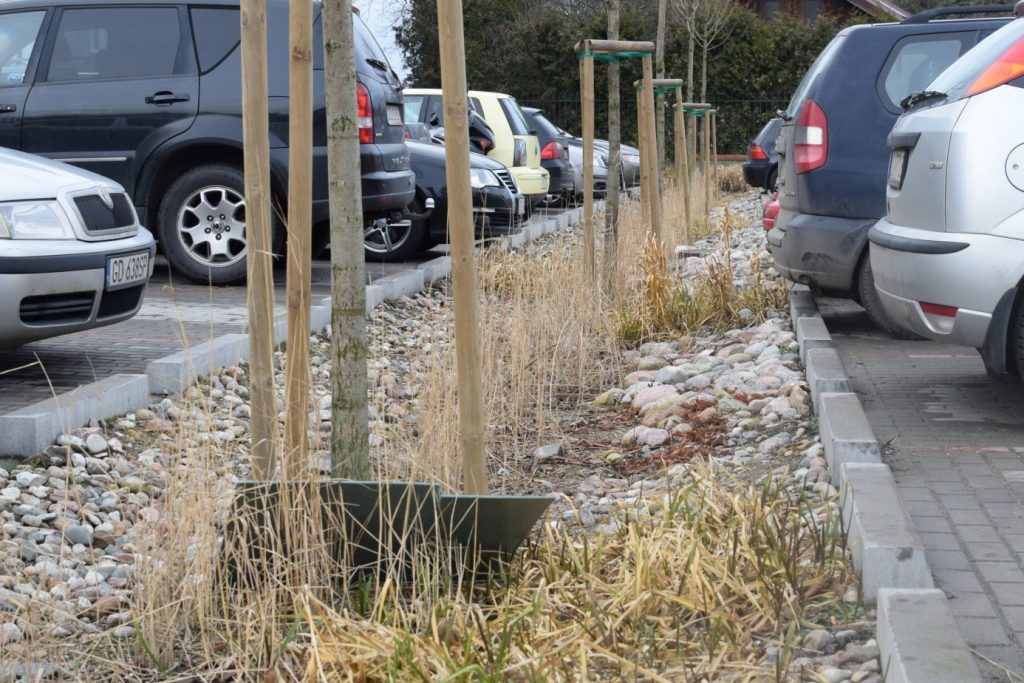
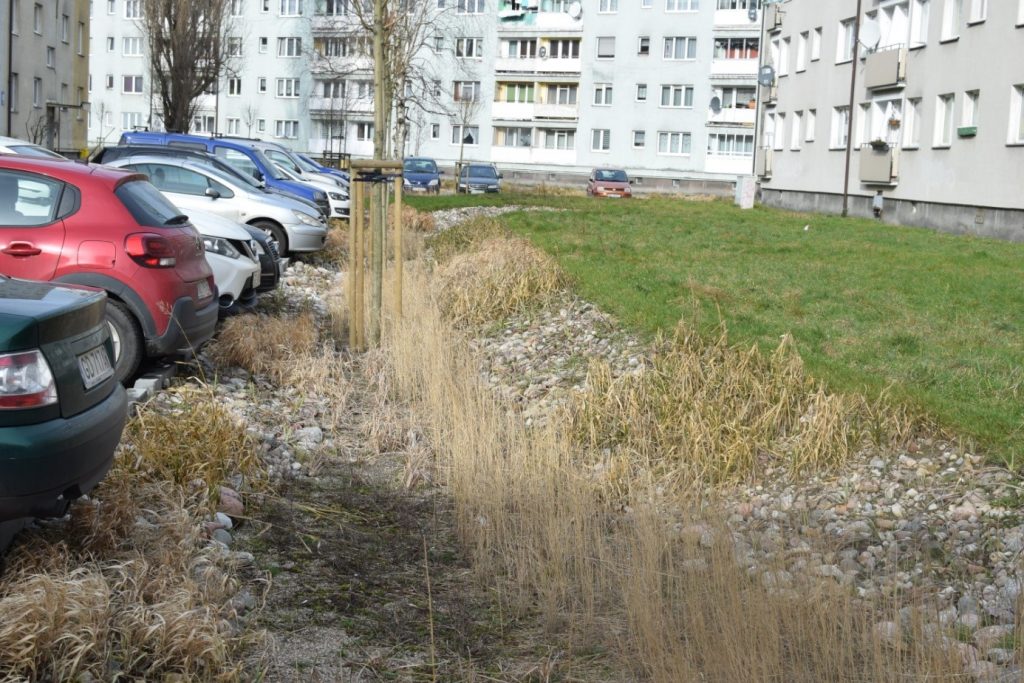
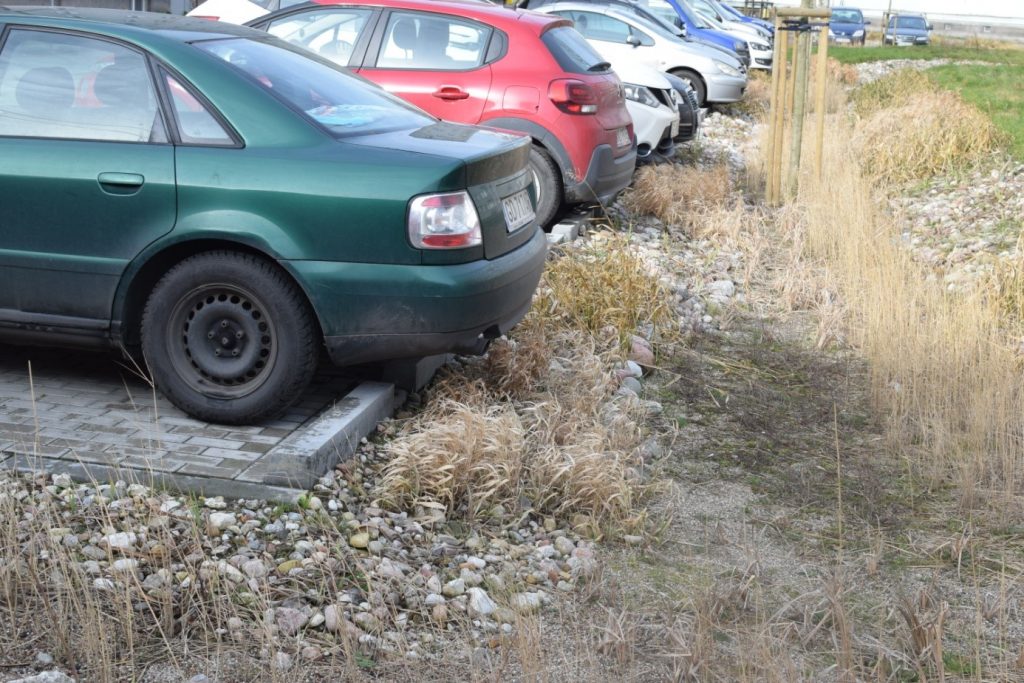
More on the topic in the Gdańsk small retention manual. https://docplayer.pl/108532856-Gdanski-poradnik-malej-retencja.html
A project from Portland, NE Siskiyou Green Street
The project of the bioswale system in the suburban estate in Portland was designed as part of the creation of the so-called green street, whose main task is rainwater retention. The bioswales were built in a place where there used to be several parking spaces, thus creating small street narrowing in some places – increasing the area of the roadside covered with vegetation. Bioswale gardens store rainwater flowing down to them from a paved surface with an area of 3,000 m2 (this water comes from car drives, streets and sidewalks). The bioswales themselves are 15 m by 2.1 m and 17.5 cm deep, the water enters them through a 45 cm wide gutter. If one of the bioswales is completely filled with rainwater, its excess is sent to the next one.
Water infiltrates the ground at a rate of 7.5 cm per hour from each bioswale. The system can store 85% of water from 25-year rains. Native species as well as ornamental plant species were used to green the bioswales. The total investment amounted to $ 20 000.
The implementation of the solution was preceded by educational campaigns and it was fully accepted by the local community. The bioswale project is considered as a catalyst – how to design and modernize public spaces in suburban areas.

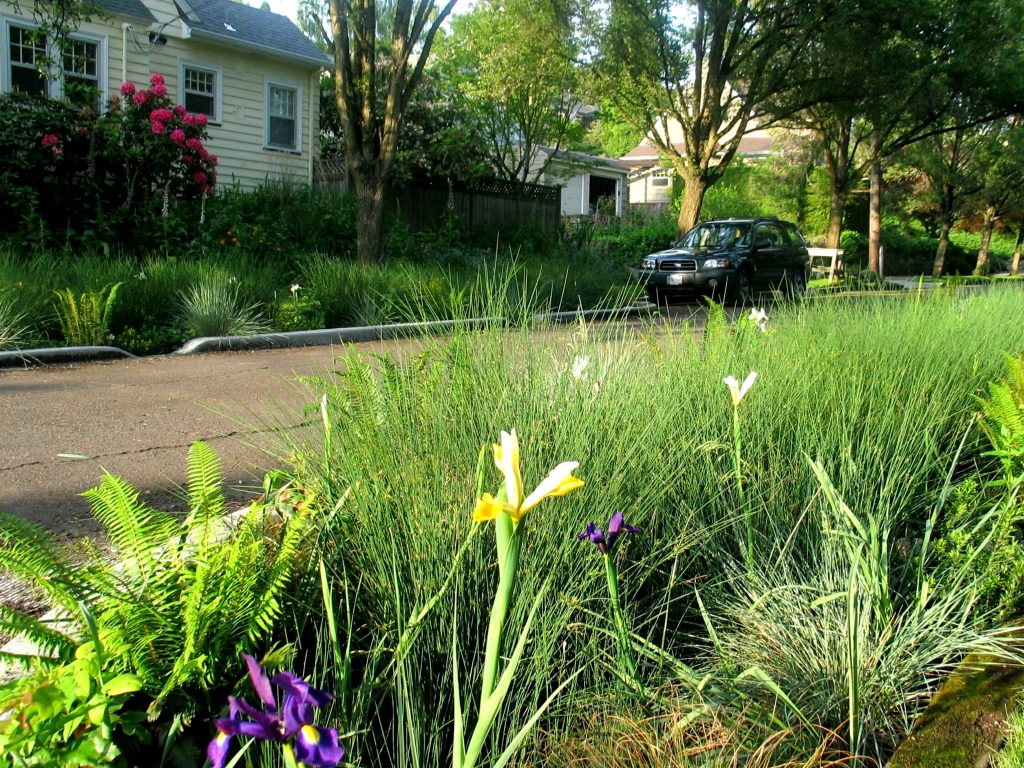

https://www.asla.org/awards/2007/07winners/images/largescale/506-10.jpg
References:
https://www.asla.org/awards/2006/06winners/341.html
http://www.cultural-landscape.us.edu.pl/images/seria/41/9dudzinska.pdf
